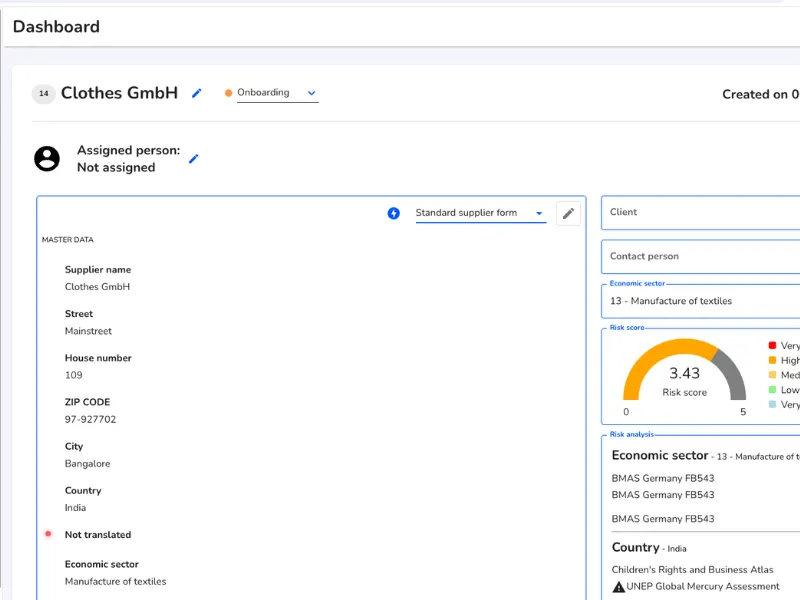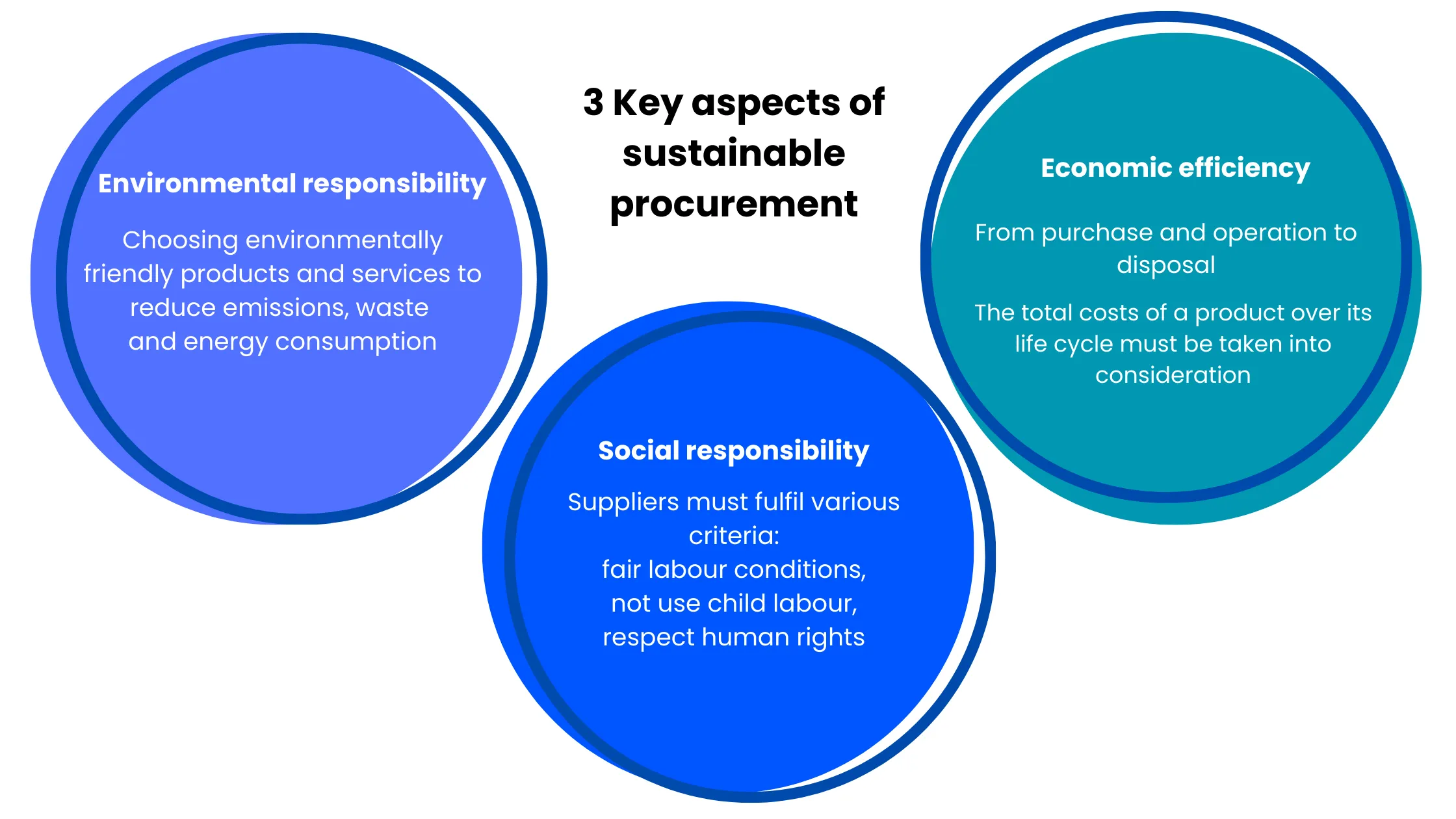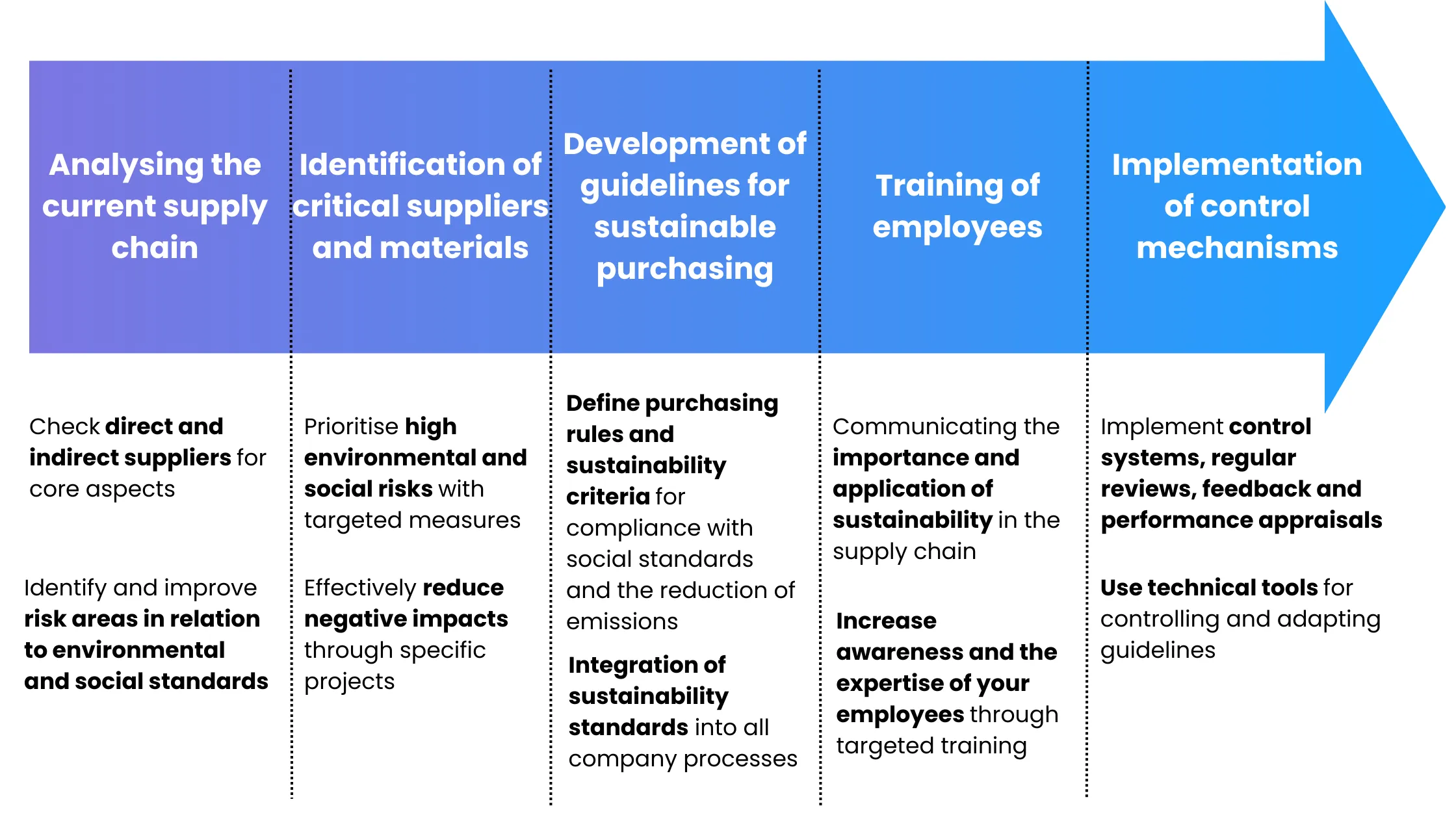Implementing sustainable procurement
April 17, 2024 • Reading time: 5 Min

Environmental protection and social responsibility are becoming increasingly important. Sustainable procurement therefore offers companies a great opportunity to act more sustainably and thus contribute to environmental protection. This is not just about reducing their own ecological footprint, but also about supporting ethical supply chains. In our article, we explain how companies can achieve high environmental and social standards by carefully selecting suppliers and materials. We also show how this can strengthen the brand and how they can contribute to the sustainability of the global economy. How do you successfully implement green procurement step by step and how do you deal with challenges? Find out more in this article.
Summary: What you should know
Sustainable procurement refers to the purchase of goods and services while considering ecological, social, and economic aspects to minimize negative impacts on the environment and society. This helps companies to act more environmentally friendly and socially responsible, which can lead to long-term economic success. Sustainable procurement considers three core aspects: ecological responsibility, which includes reducing emissions, waste, and energy consumption; social responsibility, which ensures fair working conditions and respects human rights; and economic efficiency, which takes into account the total lifecycle costs of a product. The benefits of sustainable procurement include improving brand image, better risk management, and long-term cost savings. However, there can also be drawbacks such as higher initial investments, challenges in transitioning and compliance, and limitations in supplier selection.
To implement sustainable supply chains, companies must engage all stakeholders, set clear sustainability criteria, use modern technologies and data analysis, integrate sustainability into the entire procurement process, build partnerships with sustainable suppliers, and conduct regular reviews. Sustainable procurement offers numerous advantages for companies and society, including a more stable supply chain, a better market image, and reduced environmental impact. By setting clear sustainability goals and involving all stakeholders, companies can contribute to global sustainability and strengthen their long-term competitiveness.
Subscribe to never miss any insights.
Receive regular insights and updates on the latest developments in the areas of LkSG, CSDDD, CSRD, ESRS, compliance, ESG and whistleblowing. Our newsletter helps you to simplify your compliance processes.
Definition and background
Sustainable procurement or sustainable purchasing means buying goods and services that take into account not only economic, but also social and environmental aspects. The aim is to purchase products that have as little negative impact as possible on the environment and society throughout their entire life cycle.
Sustainable procurement helps companies to act in a more environmentally friendly and socially responsible way, which can lead to greater economic success in the long term. When companies comply with environmental and social standards, they can better control risks, comply with laws and improve their reputation.
Aspects of sustainable procurement:
The following three core aspects are taken into account in sustainable procurement:
- Environmental responsibility: selection of products and services that are environmentally friendly, e.g. by reducing emissions, waste and energy consumption.
- Social responsibility: Ensuring that suppliers offer fair working conditions, do not use child labor and respect human rights.
- Economic efficiency: You should consider the costs over the entire life cycle of a product. Consideration should be given not only to how much the product costs when it is purchased, but also to the costs of operation and disposal.
In contrast to traditional procurement, which usually focuses on short-term costs and efficiency, sustainable procurement pays attention to the long-term impact of products and services. This involves looking at the total costs over the lifetime of a product, including environmental and social costs, which are often ignored in traditional procurement models.
To properly implement green procurement, it should be an integral part of the corporate strategy. Often this means changing the usual purchasing methods, which can be difficult. But in the long term, sustainable procurement brings great benefits. The main goal is to reduce environmental damage and support social justice. Companies that focus on products and services that have been produced in a fair and environmentally friendly way are committed to a more sustainable economy.
Advantages and disadvantages
Nowadays, sustainability is becoming increasingly important, which means that companies need to adapt their purchasing strategies. In addition, the way a company is run is changing worldwide, which can be attributed to green procurement. However, there are some challenges to consider.
Advantages of sustainable purchasing
Improving brand image: Companies that focus on sustainable procurement strengthen their brand image and build trust with customers and partners. Today, many consumers prefer brands that pay attention to their environmental and social impact.
Risk management: When companies build sustainability into their procurement processes, they can better manage risks such as environmental disasters, social unrest or new regulations. This helps them to avoid disruptions in the supply chain and protects their reputation.
Long-term cost savings: As sustainable procurement is more efficient and uses fewer natural resources and less energy, it can also save costs. This can result in major savings, especially in the long term.
Disadvantages of sustainable purchasing
Higher initial investment: Switching to sustainable procurement methods can be more expensive in the beginning. For example, environmentally friendly materials or fair working conditions in production could cost more than the usual methods.
Conversion and compliance challenges: Converting to green procurement usually means changing existing processes. This can lead to compliance challenges, especially in global supply chains where environmental and social standards may differ.
Limitations in supplier selection: Environmentally conscious procurement can limit the choice of suppliers because not all of them meet the necessary sustainability standards. This can be particularly difficult in specialized markets where there are few sustainable options.
Implementing sustainable supply chains: Here's how
Sustainable supply chains not only help companies to act in an environmentally friendly and socially responsible manner, but also to become more resilient and efficient. We explain the strategic steps you need to take to achieve this goal:
Stakeholder engagement
In order to successfully implement sustainable supply chains, all key stakeholders must be involved. This includes not only the teams within the company, but also suppliers, customers and stakeholders. It is important to communicate sustainability goals clearly and involve these groups regularly so that they accept and implement sustainable practices.
Defining sustainability criteria
Companies must set clear rules to ensure that their products and services are environmentally friendly. This includes avoiding harmful substances, complying with fair trade standards and emitting less CO₂(more on the CO₂ footprint). To ensure that suppliers meet the criteria, they should be integrated into all procurement guidelines and contracts.
Use of technology and data analysis
Modern technologies such as blockchain and artificial intelligence are useful for monitoring supply chains and checking whether sustainability rules are being adhered to. Data analysis helps to identify problems and make continuous improvements. Digital tools also improve the transparency of the supply chain and make it possible to see exactly where raw materials come from.
Integrating sustainability into the purchasing process
Sustainability must be integrated into all phases of the purchasing process, from the selection of suppliers through to final procurement. This includes the development of purchasing policies that support sustainability goals and the training of employees in sustainable procurement practices.
Building partnerships
It is also helpful to establish lasting relationships with suppliers who also pay attention to sustainability. Working together on things like more environmentally friendly production methods or recycling programs can further improve the sustainability of the supply chain.
Regular review and adjustment
Sustainable supply chains must be constantly reviewed and adapted. To this end, companies should regularly review their methods and carry out both internal and external audits. This is the only way to ensure that they achieve their sustainability goals. Feedback from customers and suppliers also helps to improve processes.
Building sustainable supply chains is a challenge that requires commitment and new ideas. Companies that source sustainable products not only improve their environmental footprint and their relationships in society, but also strengthen their long-term competitiveness. By setting clear sustainability goals, using different technologies for monitoring and involving all stakeholders, they can do a lot for global sustainability.
Monitor your supply chain
Guarantee sustainable procurement along the global supply chain with our LkSG tool

Guide to sustainable supply chain management
In a world where sustainability is becoming increasingly important to the success of businesses, managing the supply chain plays a major role. This guide provides practical tips on how to build a sustainable supply chain that is environmentally friendly and makes good business sense.
Step 1: Analysis of the current supply chain
Start with a detailed review of your current supply chain. List all suppliers and assess how sustainably they operate. Consider both direct and indirect suppliers and check the environmental and social risks. This investigation will help you find areas that you can improve.
Step 2: Identification of critical suppliers and materials
Find out which suppliers and materials have the greatest environmental or social risks. Determine which measures you want to tackle first to solve these problems. Plan special projects to reduce the negative effects well.
Step 3: Development of guidelines for sustainable purchasing
Define precise purchasing rules that contain clear criteria for sustainability. These rules should include the use of recycled materials, compliance with social standards and the reduction of emissions. Include these standards in all contract negotiations and purchasing processes.
Step 4: Employee training
Educate your employees. Hold training courses and workshops to explain to them why sustainability is important and how they can implement it in the supply chain. This will help everyone to know more about it and work better with sustainable methods.
Step 5: Implementation of control mechanisms
Use good control systems to check whether you are achieving your sustainability goals. Use regular reviews, feedback and performance appraisals to measure your progress and make any necessary changes. Also use technical tools so that you can monitor everything clearly and efficiently.
Sustainable procurement: a conclusion
The future viability of companies and society
Sustainable procurement is not only important and the right thing to do, it also offers companies many benefits - economic, social and environmental. When companies incorporate environmental and social standards into their supply chains, they can manage risks better, work more efficiently and strengthen their brand. The benefits are manifold: a better image, more loyal customers, lower costs due to more economical use of resources and fewer risks in the event of breaches of regulations.
Companies that have yet to switch to green procurement should first closely examine their current supply chains. This means they should assess the environmental and social impact of their suppliers and see where there is room for improvement. It is important that companies set clear targets for sustainability and build these into their business strategy. It can be a good start to launch pilot projects with selected sustainable suppliers to gain initial experience.
Sustainable procurement brings long-term benefits for companies and society. It gives companies a more stable supply chain, a better position on the market and possibly also public contracts. At the same time, the environment is less burdened and more social justice is ensured. Such measures help to reduce the ecological footprint, improve living conditions in the producing countries and ultimately contribute to a more sustainable global economy.

